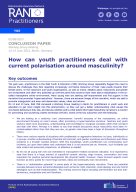Details
- Publication date
- 4 September 2023
- Author
- Directorate-General for Migration and Home Affairs
- Country
- Germany
- RAN Publications Topic
- (Early) prevention
Description
The past year, practitioners in the RAN Youth & Education (Y&E) Working Group repeatedly flagged the need to discuss the challenges they face regarding increasingly worrisome behaviour of their male pupils towards their female peers. In the classroom and youth organisations, as well as online, debates about masculinity and gender are omnipresent and often very polarised up until the point that concerns have risen about radicalisation in the socalled manosphere online environment. Many young men are seeking self-improvement and find support in the narrative that promotes ‘hypermasculinity’. However, there are extreme fringes of this narrative, which are said to promote misogynistic and even anti-democratic values, ideas and actions.
On 12 and 13 June, RAN Y&E convened a Working Group meeting in Berlin for practitioners in youth work and education to get more insight into this phenomenon, so they can get a better understanding what causes the worrisome behaviours they see, and discuss whether and to what extent this hypermasculinity narrative is a concern for preventing and countering violent extremism (P/CVE).
Some of the key outcomes were the following:
- We are looking at a relatively ‘new’ phenomenon: harmful excesses of the manosphere, an online environment focusing on men’s issues, often promoting a hypermasculine narrative. Teachers and youth workers need more awareness, understanding and knowledge to recognise excesses within that narrative and deal with them. Perhaps it is better to say that heated discussions about masculinity have been recontextualised rather than that they are new, as gender roles have been a topic of discussion throughout history.
- There were various reports of situations with problematic or aggressive behaviour by boys, individually or in groups. A better understanding of harmful anti-feminist, anti-gender narratives and influencers puts these incidents in a broader societal context. With this knowledge, youth practitioners can contextualise such incidents, act upon them better and understand that it is not personal per se. However, such incidents can take violent and extremist proportions, so attention is needed.
- By far not all young men who are interested in manosphere-related narratives radicalise. It is important to note that there is a large amount of superficial content sharing, edgy humour, provocation and even inspiration for positive personal development like physical health. However, these innocent aspects could function as entry points for more fringe content, ideas and eventually even recruitment.
- There is a ‘radicalisation potential’ in some parts of the hypermasculinity narrative. There are potential overlaps between known extremist ideologies such as the far-right, Islamism, incel ideology and new hybrid ideologies such as anti-institutionalism. This overlap concerns topics including anti-feminism but also antidemocracy, xenophobia and anti-Semitism.
- Masculinity, in all forms, good or bad, is related to our culture and society. So, parents, media, popular culture and youth professionals are all embedded in the problem and can be part of the solution. Early prevention is where society can foster individual and group resilience towards radicalisation and extremist recruitment. Professionals in youth and education can secure a positive social environment for youngsters where resilience can be strengthened and vulnerabilities can be mitigated.
In this paper, we will first share some main aspects of hypermasculinity and the manosphere that were presented in this meeting, including several principles and dynamics of the hypermasculinity narrative, constituent groups and ideological influences. Then, we will elaborate on the challenging cases practitioners have faced regarding this topic, and the discussion that followed about which attitudes and actions are a concern for P/CVE. Moreover, to understand the extremism coming forth out of parts of the hypermasculinity narrative, we have discussed the current social and emotional struggles of young men as well as their needs and grievances. Finally, we formulated recommendations and approaches youth practitioners can consider.

